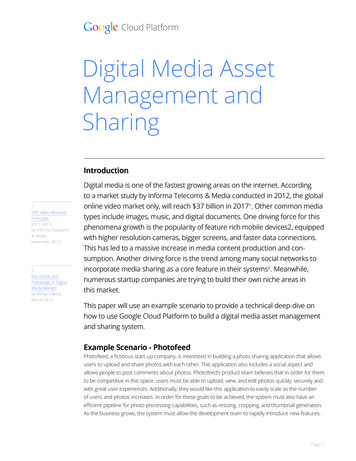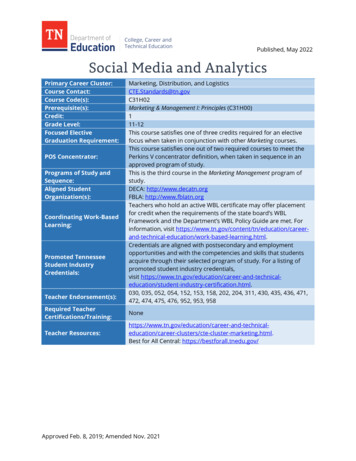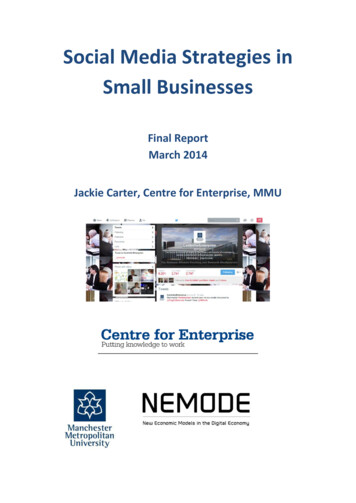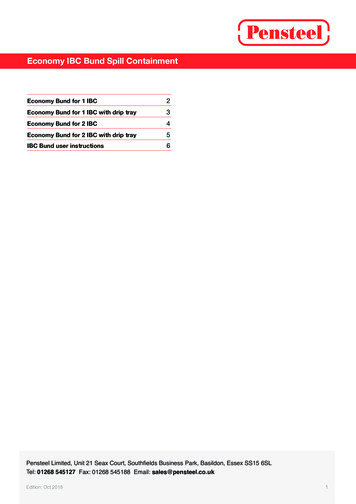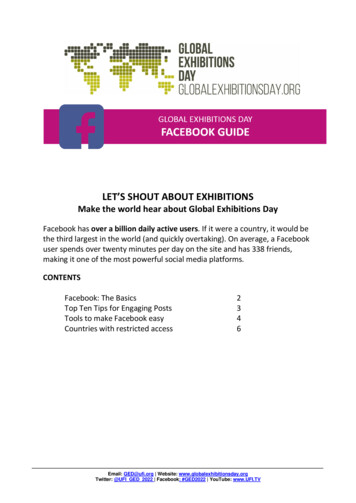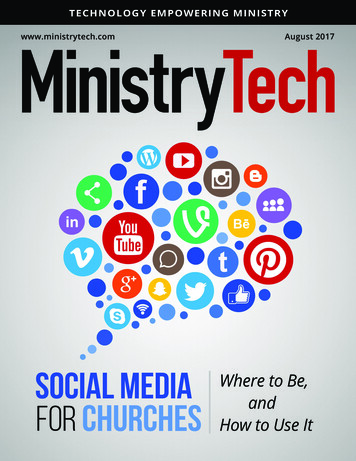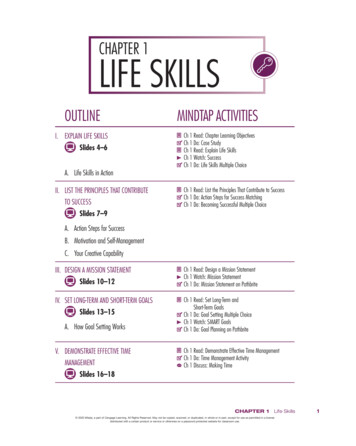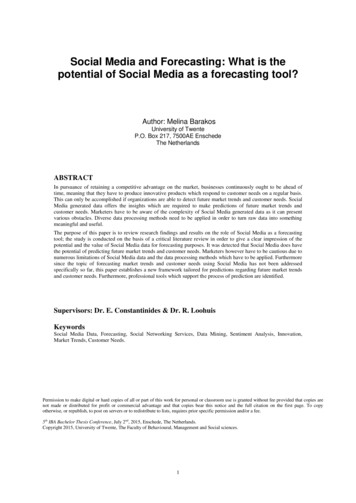
Transcription
Humankind 2.0: TheTechnologies of the Future7. Social Media and Sharing EconomyPiero Scaruffi, 2016See http://www.scaruffi.com/singular/human20.htmlfor the full text of this discussion
A pervasive phenomenon
A pervasive phenomenon The only gap remains in the age group
The world in 2007
The world in 2016
The social world in 2016 Twitter: what I thinkFacebook: what I doInstagram: picturesYouTube: videosLinkedIn: my jobPinterest: my hobbiesFoursquare: my spare timeReddit: my opinions
Asocial Networking "social media" "advertising media" Business used to be about making things thatpeople want, and the industrial revolution turnedthis business into a science. The radio and television created a new kind ofbusiness, the advertising business, that is aboutmaking people want things. Social networking represents the equivalent ofthe industrial revolution for advertising. Today, instead of advertising products, we"productise" adverts.
Asocial Networking The story of social networking media is reallya story of addictions, not of socializing gossip addiction vanity addiction voyeuraddiction Then this addiction gets "monetized" by sellingadvertising space
Asocial Networking The quality of information has declined Wikipedia– The only encyclopedia– Frequently edited by government agencies (that wantto promote their view of the facts), by corporations(that want to promote their business), by celebrities(who want to promote their image) and by specialinterest groups (that want to promote special interestslike their religion or their political views).– Wikipedia can be manipulated more than the printedencyclopedias
Asocial Networking A social network is a place where you don'tknow whether people truly exists. The social networks are populated by– "trolls” plant inflammatory statements– "bullies" harass users– "robots" steal your privacy– "spammers" bombard you with publicity– “phreaks" hijack accounts
Asocial Networking Dotcom era: the birth of Internet addiction– Ivan Goldberg : "Internet Addiction Disorder" (1995)– Kimberly Young’s "Internet Addiction - TheEmergence of a new Clinical Disorder" (1996)
Asocial Networking And then it got worse – Google (1998)– Facebook (2004)– YouTube (2005)– Reddit (2005)– Twitter (2006)– iPhone (2007)– Facebook’s "Like" button (2009)– Pinterest (2010)
Asocial Networking And then it got worse – Nicholas Carr: "The Shallows" (2011)– Sherry Turkle: "Alone Together" (2011)– "Abnormal White Matter Integrity inAdolescents with Internet Addiction Disorder“(China, 2012): Internet addiction causes brainchanges that are similar to the ones found in thebrains of alcoholics and drug addicts.– Matt Labash: "The Twidiocracy" (2013)– Alice Marwick: "Status Update" (2013)
Asocial Networking And then it got worse – Stanford Persuasive Technology Lab
Asocial Networking And then it got worse – Susan Greenfield’s article "Mind Change"(2014)– Susan Snyder (Univ of North Carolina, 2015):almost 50% of US students are addicted to theInternet, and that many young Internet addictssuffered from mental health problems such asdepression, insomnia, attention-deficit disorder,even suicidal tendencies and alcoholism.– Joseph Reagle's "Reading the Comments" (2015)
Asocial Networking Social networking is not about building acommunity but about destroying the existingphysical communities.
Asocial Networking An interesting coincidence– CDC (Center for Disease Control):the number of suicides in the USAhas been rising since 1999– 1999 happens to be the year that thefirst social network was born(Friendster)
Privacy Boom of concern for privacy– 2013: Snowden affair– 2013: Khalil Shreateh hacks into MarkZuckerberg's Facebook page Anonymity to escape network surveillance The Dark Net:– Tor browser (2008)– DuckDuckGo search engine (2008)– Wickr instant messenger (2012)– Bitcoin cryptocurrency (2009)
Socializing in the post-social world1.2.3.4.5.Makers movementHackerspace movementVolunteer-computing movementOpen-source movementCrowdfunding phenomenon19
Socializing in the post-social world Makers movement– Bay Area known for the Do-It-Yourself(DIY) culture, eg Homebrew ComputerClub– DIY movement in biotech.– Maker Faire (2006)– Tech Shop (2006 )– Hacker Dojo (2009)– Explore, don’t be afraid of failing20
Socializing in the post-social world Hackerspace movement– Hackers counterculture Chaos Computer Club (Berlin,1984) and Chaos CommunicationCongress (C3) conference Metalab (Vienna, 2006) Noisebridge (San Francisco, 2007) 2600 hackerspaces worldwide21
Socializing in the post-social world Hackerspace movement– Any kid in a small town can be a “hacker" like in SiliconValley– Hackerspaces are creating real friendships in the real world– A new way to express yourself to your friends.– Explore, don’t be afraid of failing22
Socializing in the post-social world Volunteer computing movement– Use the idle time of computers in the homes andoffices of volunteers– UC Berkeley (1999): SETI@Home (1 millioncontributors)– Stanford (2000): Folding@Home– UC Berkeley (2002): Berkeley Open Infrastructurefor Network Computing (BOINC)– IBM (2004): the World Community Grid (WCG)23
Socializing in the post-social world Open Source 7: Bill Joy’s Unix BSD1979: Eric Allman’s "delivermail"1983: Richard Stallman’s Free Software Foundation1984: MIT’s X Window1987: Perl, was released by its creator Larry Wall’s Perl1989: First GNU release1991 Guido van Rossum’s Python1991: Linus Torvalds' Linux1993: Red Hat commercializes Linux1995: Apache HTTP Server1997: Eric Raymond’s "The Cathedral and the Bazaar"1998: Netscape’s Mozilla1998: Freeware Summit in Palo Alto24
Socializing in the post-social world Open Source movement––––––2008: GitHub2008: Cloudera commercializes Hadoop2008: Cassandra2009: MongoDB2010: OpenStack2016: All software by MIT Media Lab to be bereleased to FLOSS– 2016: Apple’s Mac OS X becomes open source25
Socializing in the post-social world Open Source movement– Deep Learning: Torch (New York University), Caffe(UC Berkeley), Theano (Univ of Montreal, Canada),Tensor Flow (Google).– Robotics: Robot Operating System– Big Data: Hadoop, Cassandra, – Internet of Things: Arduino, OpenHAB26
Socializing in the post-social world Open Source movement– All major corporations donate softwareto the community– Google has released over 20 millionlines of code and over 900 projects– Facebook: 90 repositories comprisingover 40,000 commits27
Socializing in the post-social world Open Source movement– Open-source communities like GitHub(1.2 million members) feature some ofthe engineers who have the smartestideas28
Socializing in the post-social world Crowdfunding– Kickstarter 2.3 billion pledged to Kickstarterprojects (April 2016) 105,000 Successfully fundedprojects 11 million total investors– Gofundme 2 billion 12 million investors– Indiegogo: 800 millionSee https://www.kickstarter.com/help/stats for updated stats29
Socializing in the post-social world Crowdsourcing– Community-based applications– MIT’s Center for CollectiveIntelligence (2006)– Accelerate the feedback loop - HenryChesbrough’s “open innovation” (2005)– Dell's Ideastorm.com (2007):customers share ideas and collaboratewith one another and with Dell– Lego Ideas (2008)– Phillips' Simplyinnovate and OpenInovation Challenge– Waze30
Socializing in the post-social world Crowdsourcing deals (as of 2015)31
Socializing in the Office We increasingly think and work in termsof short messages (tweets and texts) Slack Decline of email32
The Future of Social Media The future of content The future of interaction33
The future of content Streaming your life live to theworld (Twitch.tv, Periscope,Meerkat )34
The future of content YouNow (New York, 2011)35
The future of content Video– Facebook passed 8 billion daily videoviews (2015)– Snapchat passed 6 billion daily videoviews (2015)– Google YouTube has over a billion users(300 hours of video added every minute)36
The future of content Apps for video editing– Google FlyLabs (New York)– Cinematique (New York)– Shutterstock's Sequence– GoPro's video editing– Flipagram (Los Angeles)37
The future of content Immersive 3D photography– Fyusion (San Francisco) VR videos– 8i (New Zealand)38
The future of interaction The social life of algorithms– In theory we interact with other people,– In practice most of the interaction takes placewith algorithms– Gartner's study : by 2018 about 20% of allbusiness content will be created by machinesand there will be 6 billion connected things– Thousands of algorithms tell us where to eat,which movie to watch, what to buy, how muchto exercise, and whom to date– And we mostly obey39
The future of interaction The social life of machines– Gartner: by 2020 virtual assistants willconstitute 40% of mobile interactions– Social life in the post-app era will be largelycontrolled by virtual assistants– Virtual assistants will also interact with smartthings around the house, the office and the city– Robots will "socialize" via the cloud.– The social life of machines will be moreinteresting than the social life of people40
The future of interaction The social life of chatbots– Facebook Messenger becomes a platform fordevelopers of chatbots41
The future of delivery Explosion of videos, live streaming,video calls, video conferencing, etc istesting the limits of 4G technology Artemis: the pcell42
Sharing Economy Sharing Economy– Monetize idling capacity: most of the timewe don’t use most of what we own43
Sharing Economy Sharing Economy– Collaborative consumption– A side-effect of the financial crisis of 2009-10– Enabled by social mobility, by Amazon/Yelpcustomer reviews (“trust”), and by a wastefulsociety (idling capacity)!44
Sharing Economy Technology is changing the future ofcapitalism from competing to sharing “By the end of this decade, power andinfluence will shift largely to those peoplewith the best reputations and trustnetworks, from people with money andnominal power giving a voice to what weonce called "the silent majority." Rachel Botsman and Roo Rogers: What’sMine is Yours (2010) Lisa Gansky: The Mesh: Why the Future ofBusiness is Sharing (2012)Craig Newmark(Craigslist)45
Sharing Economy “Glocal:” a localized version of a global service(eg Uber)46
Sharing Economy P2P Finance– Marketplace lending (LendingClub)– P2P Insurance (Lemonade)47
Sharing Economy48jwtintelligence.com
Sharing Economy Businesses must think of what value theyown besides their business Eg, motels and schools own parking lotsthat are not used for many hours during theday, a valuable asset in congested cities49
Sharing Economy Sharing Economy– Invisible sharing: the “sharing” ofresources and knowledge will be doneautomatically Waze (acquired by Google) Here (owned by BMW, Audi, andDaimler) to crowdsource informationacquired by in-car sensors to provideother cars’ drivers with more accurateinformation on traffic50
Ed-tech Education in the USA– 7% of the GDP– 12,731 per pupil on secondaryeducation– #1 in tuition fees
Edtech 1946: the USA had the #1 high schoolgraduation rate in the world Today: # 22 among 27 industrializednations US students rank 25th in math, 17th inscience and 14th in reading (OECD,2012) Only 46% of students finish college
Democratizing Education MOOCs (Massive Open Online Courses)– Khan Academy (Salman Khan, 2006): freeK12 education worldwide– SlideShare (Jon Boutelle, 2006): freerepository of slide presentations– Edmodo (Nic Borg and Jeff O'Hara, 2008):platform for teachers– Udemy (Eren Bali, 2010): onlinemarketplace where anyone can upload andsell a class
Democratizing Education MOOCs (Massive Open Online Courses)– Coursera (Andrew Ng, 2011): onlineuniversity-level courses in collaborationwith universities– Udacity (Sebastian Thrun, 2011): onlinetraining courses in collaboration withindustry– EdX (MIT & Harvard, 2012): likeCoursera but nonprofit and running onopen-source software
Democratizing Education Free encyclopedia– Wikipedia (2001)
Democratizing Education 2015 statistics– SlideShare 19.7 million slide presentations– Udemy: 40,000 courses and 10 millionstudents– EdX: 5 million students– Coursera: 15 million students– Udacity: 4 million students– Khan Academy: 10 million (per month)– Edmodo: 44 million
Startups to watch Learnist (San Francisco, 2012):teachers and students can curate contenton “Learnboards” (a knowledge socialnetwork)
Startups to watch Primo Toys (Britain, 2013): teaching the basic ofprogramming without using letters
Startups to watch Codeacademy (New York, 2011): onlineinteractive coding classes - 24 millionusers in 2015
Startups to watch Duolingo (Carnegie Mellon, 2011):nonprofit language-learning platform 10 million users in 2015
Startups to watch CareerFoundry (Germany, 2013): alearning platform plus a job-coachingservice plus a job-placement service
Gamified Education GameDesk (Univ of Southern California,2008): games as educational tools Knewton (New York, 2008): Adaptivelearning - 10 million users in 2015 KnowRe gamified Adaptive-learning ClassDojo (San Francisco, 2011): classroommanagement for teachers through real-timefeedback and online rewards - 30 millionusers in 2015
Courseware Authoring Creating interactive personalized courseware– Amplify (New York, 2000)– Blinklearning (Britain, 2009)– Top Hat Monocle (Toronto, 2010)– Pear Deck (Iowa, 2014)
Parents Involvement Mobile messaging platforms toconnect teachers, parents and students– Remind (San Francisco, 2011):mobile messaging platform - 10million users in 2015– Kaymbu (Boston, 2012)
Foundations to watch Meritful (Washington, 2012): helpingsmall firms recruit the best collegegraduates Beyond 12 (San Francisco, 2009):nonprofit tracking the careers of highschool graduates Edcamp (Pennsylvania, 2011): teacherrun "unconferences" (“edcamps”) thattake place on Saturdays and during thesummer
Edtech Incubators Imagine K12 incubator (Palo Alto, 2011)
Edtech Stanford wants to form T-shaped people67
Edtech China and the West– 1,000 years ago China was inventing everythingand the West was copying– Today the West is inventing everything andChina is copying– China has to rediscover the spirit of 1,000 yearsago68
Edtech China and the West– A very interdisciplinary spirit– Scholar-official of the Song dynasty: theuniversal man, combining the qualities ofscholar, poet, painter, statesman69
Ecotopia Leon Battista Alberti’s “On the Art ofBuilding” (1452): “the city is like agreat house, and the house in its turn asmall city.” Federico da Montefeltro’s palace inUrbino (1444-82): “a city in the form ofa palace” (Baldassare Castiglione)
Ecotopia “The Ideal City” (1480s)
Technology and Ecotopia Technology mediates between theindividual/family and the social andnatural environment The technology of 1480 was architecture,a very physical technology We are inventing the technology of the2010s, and it is increasingly virtual, notphysical
Technology and Ecotopia Physical technology mediates well if it isefficient and beautiful Urban planning until the 20th century efficiency aesthetics Urban planning of the 2010s efficiency ?
Not Ecotopia USA 1950s/1960s:– Unchecked two-dimensional expansion of urbansprawl– Boring streets make pedestrians unhappy– Skyscrapers make people lonely and neurotic
Urban growth is an environmental issue 1900: there are only 16 cities withpopulations of greater than 1 million 2015: There are more than 500 cities withpopulations of greater than 1 million 2.5 billion people expected to move to urbanareas by 2050 Urban areas are increasingly dispersed andextensive
Urban growth is an environmental issue 1950s-2010s:– US metropolitan areas increasingly dispersed– Boom of consumption– But also boom of per-capita resourceconsumption (land, water, and fossil fuels) US-style ways of urban living are notsustainable
China 2025 China’s wave of urbanization:– to move 250 million rural residents intonewly constructed towns and– to fully integrate 70% of the country’spopulation, or roughly 900 million people,into city living by 2025. “Urbanization can launch a process of valuecreation” (Xiang Songzuo, chief economist,Agric.l Bank of China)
China 2025 China’s wave of urbanization:
Anti-urbanization movement Case study: Paolo Soler’s: “Arcology” (1969, Arizona)– architecture ecology– The city as a living, breathing, evolving organism– Living in harmony with the natural world– the sprawling urban landscape replaced by dense,integrated, three-dimensional cities
Ecotopias of the 2000s Sustainable, hyper-efficient buildingsEvolving human communitiesSimcity 2000 city-building game: building arcologiesMany experiments:Norman Foster’s Masdar, UAEShimizu Corporation’s TRY Mega-City Pyramid (2004)
Ecotopia: yesterday and tomorrow Low-tech ecotopia– The move to suburbia in the 1950s wasdriven by the middle class– Enabled by car and highways– Appeal: affordable enjoyable housing –better physical life High-tech ecotopia– The move to satellite cities of the 2010sdriven by the engineers– Enabled by the smartphone and theInternet– Appeal: better online life?
The rise of Silicon Valley 1940: Silicon Valley’s urban development covers 50 km2(US Geological Survey, 1940) 2000: 750 km2 (868 autos per 1000 residents)
(trivia) BTW: the largest increase in Asianpopulation of the entire USA!
The rise of the Bay Area Bay Area: 13.5 billion in venture capitalinvestment (2011) More than four times metropolitan Boston ormetropolitan New York (second and third largestcenters for venture capital investment in the USA)
The rise of Silicon Valley2013 venture capital
Silicon Valley Technopolis: a geographically concentrated high-tech urbanentity which is characterized by– Collaborative relationships between government, industryand universities,– Risk-taking venture capital– Free movement of labor– Meritocracy– Tolerance for failure– Cosmopolitan– Networking “(coopetition”) SV is flat! No high-rise buildings! No center of town A cluster of cities with no boundaries and no personality
Silicon Valley Silicon Valley is a polycentric metropolis–––––––––––San Jose: eBay, Cisco , IBM Almaden LabsCupertino: AppleSanta Clara: IntelSunnyvale: YahooMountain View: GoogleMenlo Park: FacebookPalo Alto: VMwareRedwood City: Electronic ArtsRedwood Shores: OracleSouth San Francisco: GenentechSan Francisco: Autodesk, Twitter, Airbnb, Uber
Where’s downtown?Picture of traditional small town
The 2000s University Avenue, Palo Alto: Google, Facebook,PayPal
The 2010s Twitter, Pinterest, Airbnb, Uber :San Francisco. Jack Dorsey (Twitter’s co-founder): "Ilove the idea of an urban corporatecampus with all the energy and varietythat provides."
Venture capital by city (2005)
Venture capital by city (2014)
Top areas for VC investment94043: Googleplex - 94301: downtown Palo Alto
By citySan Francisco: 16% of total US venture investmentPalo Alto: 4.8%
The rise and fall of Silicon Valley Easy access to economic and social activity is aprimary driver of urban life The “time” factor: cost of access to transportationand activities The dominant mode of urban transport (egstreetcar or car) during a city's major growthperiods determines the city's overall developmentpattern.
The rise and fall of Silicon Valley Silicon Valley until the 2000s: fast inexpensiveauto-based transport dispersed employmentlocations sprawling highway-oriented urbangrowth and little investment in public transportand increased dispersion of employment Accessibility was not an issue Subsidized housing
The rise and fall of Silicon Valley Silicon Valley in the 2010s: expensive autobased transport poor public transport nosense of community skyrocketing realestate prices
The national trend Clusters of venture capital and technologystart-ups are shifting from shapelesssuburban boomtowns to denser populationareas
Driven by the investor 1980s:– Venture capital-backed societies– High-tech innovation hubs high-tech firms university campuses specialized services– Abundance of reusable industrial real estate is amust– Proximity to a campus is a must (proximity to ahigh-skilled labor pool)– Silicon Valley and Boston's Route 128 area
Driven by the investor 1990s and 2000s:– Silicon Valley dominates– The “decentralized, cooperative ecosystem”(AnnaLee Saxenian) wins over the bureaucraticcorporate model– Mythology of Silicon Valley becomes a magnet initself
Driven by the investor 3000 Sand Hill Rd, Menlo Park
Driven by the engineer 1970s-2000s:– High-tech firms, engineers and investors prefersuburbia, far away from the traditional industryand commerce– High-tech alone creates sprawling suburbs 2010s: “The great inversion" (Alan Ehrenhalt )– New York City, San Francisco, Boston Berlin Seoul, Beijing – Highly educated individuals drive a return tothe crowded city
Case Study:Cambridge, MA and “Route 128”
Case Study:Cambridge, MA and “Route 128” Proximity to 2 major universities (MIT, Harvard)and many Boston collegesPioneering work in computers (most of theworld’s programmers in the 1950s)300 years of startup experience (Saugus IronWorks , the first integrated ironworks in NorthAmerica, founded in 1646)Close association and seamless cooperationbetween academia, government and industry
Case Study:Cambridge, MA and “Route 128” “ Route 128” competing with Silicon Valley inthe 1980s (“mini-computer” era)But very few “ Route 128” success stories in thelast 20 years although providing brains to SiliconValley (eg Facebook)Silicon Valley adapted successfully to changingpatterns of international competition (Japanesesemiconductor boom), Route 128 failed to adapt
Case Study:Cambridge, MA and “Route 128” Causes of decline–––Defense always accounted for more than 50% of I.T.funding, but the Vietnam War ended in 1975 and thespace race slowed down after 1969 and the SovietUnion collapsed in 1991Not enough of the high-tech industry was founded byindependentsMIT and Harvard and the other schools continue toattract and graduate the best talents, but these aremore likely to find investors elsewhere
Case Study:Cambridge, MA and “Route 128” Causes of decline––Excessive partnership between academia, governmentand industry (3 different world views with 3 differentgoals), i.e. the local government over-managed(Silicon Valley let the free market build and diversifythe local economy)Emphasis on traditional values: trade secrecy(minimal flow of information in the network),corporate loyalty, (minimal labor mobility),centralized decision system, risk-averse stability (vsSilicon Valley’s decentralized informal network-basedrisk-taking industrial system)
Case Study:Cambridge, MA and “Route 128” Causes of decline–––––Bob Metcalfe’s law: the value of the network to eachnode is exponentially related to the number of nodeson the network.It is not a zero-sum gameInnovation ecosystems driven by competition actuallycreate a form of cooperation, or collective progressThe success of one increases the chances of thesuccess of anotherSilicon Valley: semiconductor to personal computersto local area networks to dotcoms to search to socialnetworks .
Case Study:Cambridge, MA and “Route 128” Causes of decline––Limited appeal of experimentation for the sake ofexperimentationGreat creativity among young people, but limitedmotivation to explore new ways of public-privatepartnerships to drive innovation
Silicon Valley-ian Ecotopia Satellite cities for high-tech industry:– Sophia Antipolis (France)– Oulu (Finland)– Skolkovo (Russia)– Hsinchu (Taiwan)– Cyberjaya (Malaysia)– Bangalore’s Electronics City (India)– Hyderabad Information Technology andEngineering Consultancy (HITEC)
Walkable Urbanism (Christopher Leinberger, George Washington University, 2012)Simulating an urban experience in a suburb by building condosand apartments on the same block, or even in the same building,with restaurants, boutiques, offices, markets, etcHome within walking distance—or at least within a fewminutes’ drive—to public transportationYoung techies want the amenities of a cityYoung techies don’t want a car
Walkable Urbanism 558 walkable urban places in the USA (2014) More:– able-urbanism (Brookings Inst)– affic-ahead.pdfShea's Mountain House development,about an hour outside of Silicon Valley.
Convergence of the digital andphysical world Internet of Things will enable many newtechnologies relevant to urban planning New model for connectivity Centers of education, creativity andinnovation
Convergence of the digital andphysical world New York– Control Group, Titan, Qualcomm and Comark:LinkNYC (10,000 communications hubs that providecity residents and visitors with free public gigabit WiFi, access to communications, information andmunicipal services)– Sep 2015: Control Group and Titan merge to formIntersection and are acquired by Sidewalk Labs.– Intersection project: expanding LinkNYC model (freeWi-Fi) to cities around the globe (intersection.com)
Art Man Bartlett’s #24hEcho for the "Hostess Project" at PPOW GalleryNic Rad’s People MatterGuthrie Lonergan: Myspace Intro PlaylistDebo Eilers: TwitterrificBrian Piana’s Ellsworth Kelly Hacked My Twitter"Johnny Cash Project"BobbyBobby’s "Mona Lisa"Friedrich Kirschner’s person2184
Bibliography
Contact www.scaruffi.comSee http://www.scaruffi.com/singular/human20.htmlfor the full text of this discussion117
Business used to be about making things that people want, and the industrial revolution turned this business into a science. The radio and television created a new kind of business, the advertising business, that is about making people want things. Social networking represents the equivalent of the industrial revolution for advertising.

